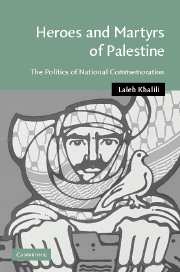Book contents
- Frontmatter
- Contents
- Acknowledgments
- List of abbreviations
- 1 Introduction
- 2 Transnational movements and discourses
- 3 Palestinian lives and local institutions in the camps of Lebanon
- 4 Forms of commemoration
- 5 Contents of commemoration: narratives of heroism, suffering, and sumud
- 6 Guerrillas and martyrs: the evolution of national “heroes”
- 7 Between battles and massacres: commemorating violent events
- 8 Commemoration in the Occupied Palestinian Territories
- 9 Conclusions
- Bibliography
- Index
- Cambridge Middle East Studies 27
7 - Between battles and massacres: commemorating violent events
Published online by Cambridge University Press: 22 September 2009
- Frontmatter
- Contents
- Acknowledgments
- List of abbreviations
- 1 Introduction
- 2 Transnational movements and discourses
- 3 Palestinian lives and local institutions in the camps of Lebanon
- 4 Forms of commemoration
- 5 Contents of commemoration: narratives of heroism, suffering, and sumud
- 6 Guerrillas and martyrs: the evolution of national “heroes”
- 7 Between battles and massacres: commemorating violent events
- 8 Commemoration in the Occupied Palestinian Territories
- 9 Conclusions
- Bibliography
- Index
- Cambridge Middle East Studies 27
Summary
Grief is a white bird
That does not come near the battlefields.
Soldiers sin who grieve.
Over there I was a machine, spitting out fire and death,
Turning space into a black bird.
Mahmud Darwish, “A Soldier Dreams of White Lilies”We could not find a thing to show our own identity except our blood in stains upon the wall.
Mahmud Darwish, “Beirut”In the aftermath of the first bloody siege of Shatila by the Amal militia in 1985, Umm Muhammad, resident of Shatila, declared that the siege wasn't “the first massacre that has been committed against us. Since 1947 our lives have been affected by them. My four children and husband were killed at the hand of the Israelis and the Kata'ib in the Sabra and Shatila massacres – even those Lebanese who were married to Palestinians were killed there” (al-Hurriyya, 8 Feb. 1985: 14). For Umm Muhammad, the siege was unambiguously one in a long chain of massacres committed against Palestinians. It was the historic persistence of massacres that created an “us” against whom atrocities were committed. This “us” was the Palestinian refugee, whose political identity was so dangerous that even Lebanese citizens married to Palestinians were targets of violence. While Umm Muhammad considered the War of the Camps – as the successive sieges of the camp by Amal came to be known – as one massacre in a chain of massacres, the conflict has also been described as a heroic battle, and as an example of quotidian steadfastness.
- Type
- Chapter
- Information
- Heroes and Martyrs of PalestineThe Politics of National Commemoration, pp. 150 - 186Publisher: Cambridge University PressPrint publication year: 2007



